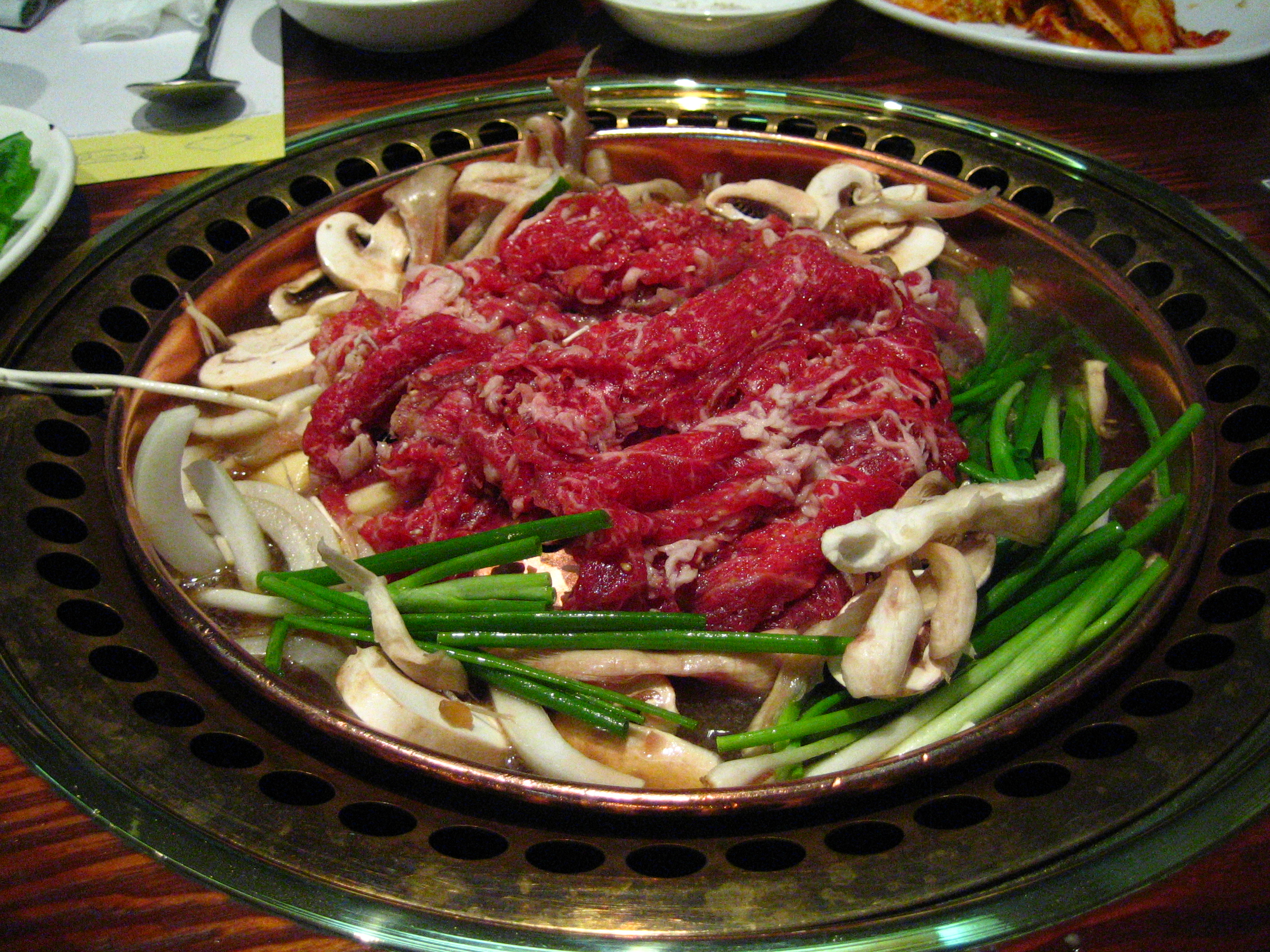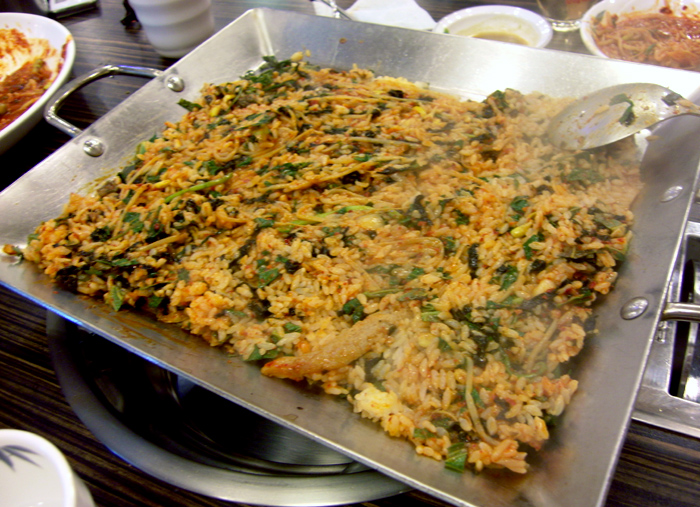|
List Of Korean Dishes
Below is a list of dishes found in Korean cuisine. Korean dishes by type Royal court dishes * Gujeolpan (구절판): literally "nine-sectioned plate", this elaborate dish consists of a number of different vegetables and meats served with thin pancakes. It is served usually at special occasions such as weddings, and is associated with royalty. *Sinseollo (신선로): An elaborate dish of meat and vegetables cooked in a rich broth. It is served in a large silver vessel with a hole in the center, where hot embers are placed to keep the dish hot throughout the meal. Grilled dishes * Bulgogi (불고기) - thinly sliced or shredded beef marinated in soy sauce, sesame oil, garlic, sugar, scallions, and black pepper, cooked on a grill (sometimes at the table). ''Bulgogi'' literally means "fire meat." Variations include pork (''dwaeji bulgogi'', 돼지불고기), chicken (''dak bulgogi'' 닭불고기), or squid (''ojingeo bulgogi'', 오징어불고기). * Galbi (갈비) - pork or bee ... [...More Info...] [...Related Items...] OR: [Wikipedia] [Google] [Baidu] |
Korean Cuisine
Korean cuisine has evolved through centuries of social and political change. Originating from ancient agricultural and nomadic traditions in Korea and southern Manchuria, Korean cuisine reflects a complex interaction of the natural environment and different cultural trends. Korean cuisine is largely based on rice, vegetables, seafood and (at least in South Korea) meats. Dairy is largely absent from the traditional Korean diet. Traditional Korean meals are named for the number of side dishes (반찬; 飯饌; ''banchan'') that accompany steam-cooked short-grain rice. Kimchi is served at nearly every meal. Commonly used ingredients include sesame oil, ''doenjang'' (fermented bean paste), soy sauce, salt, garlic, ginger, ''gochugaru'' (pepper flakes), '' gochujang'' (fermented red chili paste) and napa cabbage. Ingredients and dishes vary by province. Many regional dishes have become national, and dishes that were once regional have proliferated in different variations ... [...More Info...] [...Related Items...] OR: [Wikipedia] [Google] [Baidu] |
Gyeongsang
Gyeongsang ( ko, 경상도, ''Gyeongsang-do''; ) was one of the eight provinces of Korea during the Joseon dynasty. Gyeongsang was located in the southeast of Korea. The provincial capital was Daegu. The region was the birthplace of the Kingdom of Silla. The region also has a significant role in modern Korean history, since seven previous South Korean presidents (Park Chung-hee, Roh Tae-woo, Chun Doo-hwan, Kim Young-sam, Roh Moo-hyun, Park Geun-hye, and Moon Jae-in) were born in the Gyeongsang region. Today, the region is divided into 5 administrative divisions: the three independent cities of Busan, Daegu and Ulsan, and the two provinces of Gyeongsangbuk-do and Gyeongsangnam-do. The largest city in the region is Busan, followed by Daegu. Sub-regionally, the region is also divided into Gyeongbuk and Gyeongnam. Gyeongbuk consists of Daegu and Gyeongsangbuk-do, while Gyeongnam consists of Busan, Ulsan and Gyeongsangnam-do. History The predecessor to Gyeongsang Province was form ... [...More Info...] [...Related Items...] OR: [Wikipedia] [Google] [Baidu] |
Abalone
Abalone ( or ; via Spanish , from Rumsen ''aulón'') is a common name for any of a group of small to very large marine gastropod molluscs in the family (biology), family Haliotidae. Other common name In biology, a common name of a taxon or organism (also known as a vernacular name, English name, colloquial name, country name, popular name, or farmer's name) is a name that is based on the normal language of everyday life; and is often contrast ...s are ear shells, sea ears, and, rarely, muttonfish or muttonshells in parts of Australia, ormer in United Kingdom, the UK, perlemoen in South Africa, and paua in New Zealand. Abalones are marine snails. Their taxonomy puts them in the family Haliotidae, which contains only one genus, ''Haliotis'', which once contained six subgenera. These subgenera have become alternate representations of ''Haliotis''. The number of species recognized worldwide ranges between 30 and 130 with over 230 species-level taxa described. The most comprehen ... [...More Info...] [...Related Items...] OR: [Wikipedia] [Google] [Baidu] |
Kongnamul
Soybean sprout is a culinary vegetable grown by sprouting soybeans. It can be grown by placing and watering the sprouted soybeans in the shade until the roots grow long. Soybean sprouts are extensively cultivated and consumed in Asian countries. History It is assumed that soybean sprouts have been eaten since the Three Kingdoms of Korea. Records of ''kongnamul'' cultivation are found in an early 13th century medical book, '' Emergency Folk Medicine Remedies'', published in Goryeo. The book states that in 935, during the foundation of Goryeo, a Taebong general, Bae Hyeon-gyeong, offered soybean sprouts to starving soldiers. Cooking methods of soybean sprout dishes are listed in ''Farm Management'', a Joseon farming and living book. Another Joseon document, '' Literary Miscellany of Seongho'', states that the poor used soybean sprouts to make ''juk'' (rice porridge). According to '' Complete Works of Cheongjanggwan'', an essay collection from the Joseon era, soybean sprout was o ... [...More Info...] [...Related Items...] OR: [Wikipedia] [Google] [Baidu] |
Styela Clava
''Styela clava'' is a solitary, subtidal ascidian tunicate. It has a variety of common names such as the stalked sea squirt, clubbed tunicate, Asian tunicate, leathery sea squirt, or rough sea squirt. As its common names suggest, ''S. clava'' is club-shaped with an elongated oval body and a long peduncle for attaching to a substrate. Although native to the northwestern waters of the Pacific Ocean, since the 1900s, ''S. clava'' has become an increasingly successful invasive species outside of its native range. It is edible. Morphology ''S. clava'' is a solitary tunicate. Including both the club-shaped body and peduncle, larger specimen of ''S. clava'' can have a maximum length of around 130 mm (5.1 in) and smaller specimen only reaching 30 mm (1.2 in) in length. Smaller specimen tend to have no distinct peduncle. As described by some of its common names, ''S. clava'' has a tough, wrinkled or irregularly grooved skin and comes in two variations of color depe ... [...More Info...] [...Related Items...] OR: [Wikipedia] [Google] [Baidu] |
Agujjim
''Agwi-jjim'' * () or ''agu-jjim'' () is a Korean ''jjim'' dish made with blackmouth angler, the fish known as ''agwi'' in Korean. The name of the dish is usually translated as "braised spicy angler". The dish is seasoned with hot chili pepper powder, doenjang, ''ganjang'' (soy sauce), minced garlic, and chopped scallions to make it spicy and hot. However, other ingredients such as ''kongnamul'' (soybean sprouts), ''mideodeok'' (미더덕, ''Styela clava''), and ''minari'' (미나리, ''Oenanthe javanica'') also play an important role in giving ''agujjim'' a refreshing and fragrant flavor. The fish is an excellent source of protein and a has rich taste as well as a palatable chewy texture. History Its origins are known to be a fish market in the city of Masan, South Gyeongsang Province where local fishermen would ask cooks from the market eateries to create a tasty dish from the ugly fish. Until the 1940s, the fish was not eaten and was frequently discarded due to its ugly ... [...More Info...] [...Related Items...] OR: [Wikipedia] [Google] [Baidu] |
Cellophane Noodles
Cellophane noodles, or fensi (), sometimes called glass noodles, are a type of transparent noodle made from starch (such as mung bean starch, potato starch, sweet potato starch, tapioca, or canna starch) and water. A stabilizer such as chitosan (or alum, illegal in some jurisdictions) may also be used. They are generally sold in dried form, soaked to reconstitute, then used in soups, stir-fried dishes, or spring rolls. They are called "cellophane noodles" or "glass noodles" because of their cellophane- or glass-like transparency when cooked. Cellophane noodles should not be confused with rice vermicelli, which are made from rice and are white in color rather than clear (after cooking in water). Varieties Cellophane noodles are made from a variety of starches. In China, cellophane noodles are usually made of mung bean starch or sweet potato starch. Chinese varieties made from mung bean starch are called Chinese vermicelli, bean threads, or bean thread noodles. Chinese varietie ... [...More Info...] [...Related Items...] OR: [Wikipedia] [Google] [Baidu] |
Andong Jjimdak
Andong-jjimdak () is a variety of ''jjim'' (a Korean steamed or boiled dish), which originated in the city of Andong, Gyeongsangbuk-do Province and is made with chicken, various vegetables Marination, marinated in a ''ganjang'' (Soy sauce#Korean, Korean soy sauce) based sauce. The name literally means "steamed chicken of Andong." Origin There are many speculations on the origin of the dish. One is that it is a specialty food of the inner rich village of Andong during the Joseon period, prepared and eaten for special occasions. Another assumption is that during the 1980s in the ''Dak golmok'' (닭골목, literally "chicken alley") of the "Andong Gu Market," restaurant owners there made a dish including ingredients that regulars demanded, which became the current ''Andong-jjimdak''. The most plausible speculation among existing assumptions is that merchants of the ''Dak golmok'' at the market created the dish to keep their position against the rapid expansion of Western fried c ... [...More Info...] [...Related Items...] OR: [Wikipedia] [Google] [Baidu] |
Ganjang
Soy sauce (also called simply soy in American English and soya sauce in British English) is a liquid condiment of Chinese origin, traditionally made from a fermented paste of soybeans, roasted grain, brine, and '' Aspergillus oryzae'' or ''Aspergillus sojae'' molds. It is considered to contain a strong umami taste. Soy sauce in its current form was created about 2,200 years ago during the Western Han dynasty of ancient China, and it has spread throughout East and Southeast Asia where it is used in cooking and as a condiment. Use and storage Soy sauce can be added directly to food, and is used as a dip or salt flavor in cooking. It is often eaten with rice, noodles, and sushi or sashimi, or can also be mixed with ground wasabi for dipping. Bottles of soy sauce for salty seasoning of various foods are common on restaurant tables in many countries. Soy sauce can be stored at room temperature. History East Asia China Soy sauce (, ) is considered almost as old as soy ... [...More Info...] [...Related Items...] OR: [Wikipedia] [Google] [Baidu] |
Galbi
''Galbi'' * (), ''galbi-gui'' (), or grilled ribs, is a type of ''gui'' (grilled dish) in Korean cuisine. "''Galbi''" is the Korean word for "rib", and the dish is usually made with beef short ribs. When pork spare ribs or another meat is used instead, the dish is named accordingly. ''Galbi'' is served raw, then cooked on tabletop grills usually by the diners themselves. The dish may be marinated in a sweet and savory sauce usually containing soy sauce, garlic, and sugar. Both non-marinated and marinated ''galbi'' are often featured in Korean barbecue. This and many other dishes in Korean barbecue influenced Yakiniku as seen in the use of galbi (coined as karubi). Preparation Cuts and marination Traditionally, ''galbi'' is cut to expose one smooth bone along the short edge with the meat uniformly filleted in flat layers. An alternative cut, "LA ''galbi''", also known as a flanken cut, features cut bones peeking out along the long edge. The method was developed by Korean ... [...More Info...] [...Related Items...] OR: [Wikipedia] [Google] [Baidu] |
Galbijjim
Galbi-jjim * () or braised short ribs is a variety of ''jjim'' or Korean steamed dish made with ''galbi'' (갈비, short rib). ''Galbijjim'' is generally made with beef or pork (돼지, dweji) short ribs. In the latter case, it is called ''dweji galbijjim'' (돼지갈비찜). Galbijjim at History In traditional cuisine, ''galbijjim'' was traditionally eaten at '''' along with '''', '' |
Gim (Korean Food)
Gim (), also romanized as kim, is a generic term for a group of edible seaweeds dried to be used as an ingredient in Korean cuisine, consisting of various species in the genera ''Pyropia'' and ''Porphyra'', including '' P. tenera'', ''P. yezoensis'', ''P. suborbiculata'', ''P. pseudolinearis'', ''P. dentata'', and ''P. seriata''. Along with ''miyeok'' and '' dasima'', ''gim'' is one of the most widely cultivated and consumed types of seaweed in Korea. The dried sheets of gim are often rolled to wrap and be eaten with rice. Gimbap is a fancier adaptation, in which gim is not only rolled with rice, but also meat, fish, or vegetables. Gim also can be eaten without rice by roasting with sesame oil or frying and cutting it to make side dishes (''banchan'') such as bugak. History The earliest mention of edible seaweed in Korea is recorded in the ''Memorabilia of the Three Kingdoms'' ( 1280s); this text, created during the Goryeo era, documents the history of the Three Kingdoms Period ... [...More Info...] [...Related Items...] OR: [Wikipedia] [Google] [Baidu] |



_Merr.%2C_1804.jpg)




